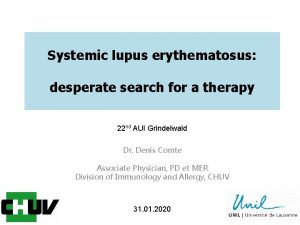The Characteristics of a Systemic Lupus Erythematosus SLE

- Slides: 1

The Characteristics of a Systemic Lupus Erythematosus (SLE) National Cohort Kaleb 1, 7 Michaud , Robert 2 Katz , 3 Petri , 4 Alarcón , 5 Chakravarty , 6 Goldman , Michelle Graciela S. Eliza John The Systemic Lupus Erythematosus in the Community Study Group. Frederick 7 Wolfe , 1 University of Nebraska Medical Center, Omaha, NE; 2 Rush Medical Center, Chicago, IL; 3 John Hopkins University, Baltimore, MD; 4 University of Alabama at Birmingham, AL; 5 Stanford University, Stanford, CA; 6 Emory University, Atlanta, GA; 7 National Data Bank for Rheumatic Diseases, Wichita, KS Abstract PURPOSE. Much of what is known about patients with systemic lupus erythematosus (SLE) comes from tertiary referral centers. SLE patients in the community are often not captured in research reports because their physicians are not part of the tertiary network. We have built a database of SLE patients through physician referral and patient self-enrollment. In this report we investigate the characteristics and differences between self-referred (N=303) and physician referred (N=814) participants. METHODS. SLE patients were enrolled in the databank beginning in 1998 by referral from 144 US rheumatologists or by self-referral. Self-referred patients were informed about this study by lupus publications, internet communications and physician information. Patients report about their illnesses semiannually, and critical outcomes are verified by medical records. After self referral, we initiated diagnosis confirmation by physician contact. RESULTS. The mean age of the 1, 117 participants was 50. 7 years and 93. 7% were women. Most (84. 0%) received their SLE care from rheumatologists. Work disability occurred in 22. 2% and was more common in those reporting elevated creatinine odds ratio (OR) 2. 7 (95% CI 1. 4 -5. 2), Medical Research Council (MRC) Class 3 dyspnea OR 3. 3 (2. 7 -5. 1), myocardial infarction OR 1. 9 (1. 1 -3. 6) and stroke OR 3. 1 (1. 3 -7. 1). The annualized direct medical costs were US $8840, and 16. 3% were hospitalized semiannually. In a subset of 325 patients, the Systemic Lupus Erythematosus Questionnaire (SLAQ) score was 10. 9 (SD 6. 9). Among SLE therapies, use was: hydroxychloroquine 60. 3%, prednisone 47. 4%, methotrexate 16. 4%, azathioprine 10. 6%, mycophenolate 8. 9%, leflunomide 2. 1%, cyclophosphamide 1. 2% and rituximab 1. 0%. We compared self-referred and MDreferred patients for key SLE variables (Table 1). Self-referred patients were younger, and had slightly more abnormal values for proteinuria/hematuria, dyspnea, depression and the SF-36 mental component score. Introduction Most data on SLE comes from research conducted in tertiary centers. In addition, such research tends primarily to use physician and laboratory data, and pays less attention to patient outcomes. The Systemic Lupus Erythematosus in the Community (SLEC) had several aims, including increasing understanding of SLE patient outcomes and tapping into the large body of SLE that is seen by community physicians such as community rheumatologists and primary care physicians. In addition to accepting referrals from physicians, we opened up this project to self-referral by patients. This is a potentially hazardous decision as patients may enroll as having lupus but, who, in reality, do not have that illness. The National Data Bank for Rheumatic Diseases (NDB) tackled this problem by asking patients for permission to contact their physicians to validate the diagnosis. In the report that follows, we make use of data from physician and self referral to describe the characteristics of this growing data bank and its potential for assessing patient outcomes. Table 1. Characteristics of Physician and Self-referred SLE Patients CONCLUSIONS. Self-referred SLE patients are generally similar to MD-referred patients in this cohort. The most common therapies are hydroxychloroquine and prednisone. Direct medical costs and work disability are high, and are associated with illness severity. Patient-based data banks offer another valuable resource for the study of SLE. Overall, self-referred patients have slightly greater severity on self-report items. However, when only physician validates SLE patients are analyzed these difference become very small. The NDB is an independent, non-profit research data bank dedicated to rheumatology and patients with rheumatic diseases. We invite rheumatologists to join the NDB and help with this research. Stop by at Booth 575 for more information. Conclusions Self-referred SLE patients are generally similar to MD-referred patients in this cohort. The most common therapies are hydroxychloroquine and prednisone. Direct medical costs and work disability are high, and are associated with illness severity. Patientbased data banks offer another valuable resource for the study of SLE

